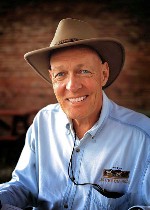-
(b.) -1939 February 06(d.)2005 December 22
Bio/Description
Born in Alva, Oklahoma; over the course of his life, he lived all over the American west but always called Alva home. He received a Bachelor of Science, Physics degree and Master of Science and Ph.D., Engineering degrees from Oklahoma State University in 1959, 1962 and 1964, respectively. He immediately began his technical career at the Loveland Instrument Division of the Hewlett-Packard Company in Loveland, Colorado. he was drawn to computing. His PhD thesis topic was analog computing and he formed a team at HP during the late 1960s that developed an analog computer named the Synchro-Rectro-Flash. The computer never made it to production and the abandoned prototype spent several years hidden in a ventilation-system closet at the HP plant in Loveland until he spirited it away one weekend to a barn on his wheat farm near Ft. Morgan, Colorado. Even though the Synchro-Rectro-Flash didn?t become a product, his interest in computers didn?t wane. By the early 1970s, he was working on early research for a new, unnamed algebraic programming language that would first appear in HP?s 9820A desktop calculator. HP would eventually name this language HPL. It would flower in the HP 9825A desktop calculator, an extremely successful computer introduced in 1976. He managed the overall development of that machine. By 1977, he started managing an advanced semiconductor-development project for HP called Focus. The project was designed to leapfrog HP years ahead of commercial semiconductor vendors by producing a 32-bit microprocessor and large memory chips for HP?s desktop computers. In his role as the overall manager of the Focus project, he was given access to divisional resources across all of HP, unprecedented power for anyone at the company except for Bill Hewlett, Dave Packard, and perhaps the legendary head of HP Labs, Barney Oliver. The Focus project launched HP into the engineering workstation business. After serving as General Manager for a few of HP?s computer divisions over an eight-year period, he left HP in 1986 to become President of Allied Signal Corp?s Bendix/King subsidiary. Typically, he became intensely interested in King Radio because he wanted improved communications gear for his private aircraft. His interest led him to become the subsidiary?s President. He left Bendix/King in 1989 to become the President and CEO of Iomega Corp, an early player in removable and external mass-storage products for IBM PCs. He left Iomega in 1995 to become the President, CEO, and a director of keyboard manufacturer Key Tronic Corp. He was noted for taking Bendix/King, Iomega, and Key Tronic to new levels of productivity and profitability. While at Iomega and Key Tronic, he also served as a Director of the Norand Corp of Cedar Rapids, Iowa. Norand made a proprietary line of handheld computers. He also served as a Director of the Hach Company (Loveland, Colorado), a maker of water-quality test equipment and reagent chemicals, and Raser Technologies (Provo, Utah), a technology licensing firm that focuses on motors and motor controllers. In addition to his successful high-technology engineering and management career, he was a farmer and rancher. He grew wheat in Colorado and had a game-hunting preserve called the Wing and Rack in Oklahoma. He married Kay Magnuson in 1960, and together they had two sons. In 1985, he married Betty Dawson. He died December 22, 2005 at the age of 66.
-
Date of Birth:
1939 February 06 -
Date of Death:
2005 December 22 -
Noted For:
Led the team that developed an analog computer prototype named the Synchro-Rectro-Flash in the late 60’s; conducted early research for a new, algebraic programming language that would first appear in HP’s 9820A desktop calculator and would eventually be named HPL; also managed an advanced semiconductor-development project called Focus which produced a 32-bit microprocessor and large memory chips for HP’s desktop computers -
Category of Achievement:
-
More Info:


